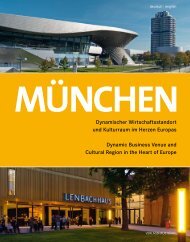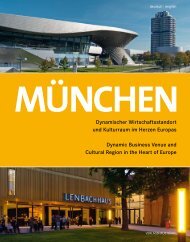Buch_Muenchen
You also want an ePaper? Increase the reach of your titles
YUMPU automatically turns print PDFs into web optimized ePapers that Google loves.
„Jagd auf Nilpferd und Krokodil“<br />
ist der Titel des von Peter<br />
Paul Rubens 1617 geschaffenen<br />
Gemäldes, zu betrachten in der<br />
Alten Pinakothek<br />
"The Hippopotamus and<br />
Crocodile Hunt" is the title of<br />
the work painted by Peter Paul<br />
Rubens in 1617 and now on<br />
display in the Alte Pinakothek<br />
denn die Firma OSRAM hat in enger Zusammenarbeit<br />
mit dem Lenbachhaus, dem Baureferat der Stadt<br />
München sowie dem Künstler Dietmar Tanterl eine für<br />
den Museumsbereich wegweisende Ausstellungsbeleuchtung<br />
entwickelt: künstliche Beleuchtung, die sich<br />
kaum vom Tageslicht unterscheidet, die konservatorischen<br />
Anforderungen in höchstem Maß erfüllt und<br />
neue Gestaltungsmöglichkeiten durch variable Lichtfarben<br />
eröffnet. Damit wird das Lenbachhaus nach der<br />
Generalsanierung in seinen Ausstellungsräumen neue<br />
Qualitätsstandards für Kunstmuseen setzen.<br />
Neben der Villa aus dem 19. Jahrhundert, dem Kernstück<br />
des Museums, entstand Anfang der 1990er Jahre<br />
der unterirdische Kunstbau. Eine moderne Ausstellungshalle<br />
im Zwischengeschoss des U-Bahnhofes<br />
Königsplatz, die in ihren Ausmaßen von 120 Metern<br />
Länge auf 14 Metern Breite dem darunter liegenden<br />
U-Bahnhof entspricht. In dem vom Münchner Architekten<br />
Uwe Kiessler umgebauten Ausstellungsraum<br />
finden Ausstellungen von der Klassischen Moderne bis<br />
hin zu aktuell diskutierten Künstlern statt.<br />
Ein weiteres Beispiel dafür, wie eine frühere Künstlervilla<br />
sowohl dem historischen Vermächtnis als auch<br />
der Kunst der Gegenwart gerecht werden kann, ist die<br />
Villa Stuck. Der neoklassizistische, palastartige Bau in<br />
der Prinzregentenstraße ist das ehemalige Wohnhaus<br />
Alongside the 19th century villa – the centrepiece of<br />
the museum – the subterranean art museum was built<br />
in the 90s. It is a modern exhibition hall in the mezzanine<br />
above the Königsplatz subway station, and with<br />
the same dimensions of 120 x 14 metres. Exhibitions<br />
from the classical modern through to hotly discussed<br />
contemporary artists are held in this gallery, which<br />
was remodelled for this purpose by the Munich architect<br />
Uwe Kiessler.<br />
Another example of how a former artist’s villa can serve<br />
both the historical legacy and modern day art is the<br />
Villa Stuck. This neo-classical palace in Prinzregentenstrasse<br />
was the home of the Bavarian painter and<br />
sculptor Franz von Stuck, who designed the luxurious<br />
villa himself and who included a studio building in the<br />
plan. Stuck, co-founder of the Munich Secession and<br />
teacher of, among others, Wassily Kandinsky and Paul<br />
Klee at the Academy of Fine Arts, was a major artist of<br />
his time. The villa is today home to the historical living<br />
and painting rooms of Franz von Stuck as well as to<br />
rooms for special exhibitions. The collection of Franz<br />
von Stuck works is complemented by objects from the<br />
field of fine arts from the turn of the century, in particular<br />
Art Nouveau. Special exhibitions on topics from the<br />
historical and artistic context of Franz von Stuck and<br />
the fields of fine and applied arts of the 20th century<br />
round off the museum’s highly attractive programme.<br />
ART and culture 193




